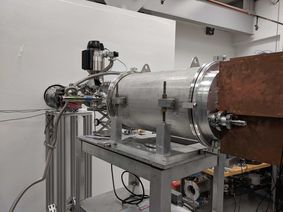Prototype Active-Target Time-Projection-Chamber/ND-Cube

The Prototype Active-Target Time-Projection Chamber (PAT-TPC) and the ND-Cube are active-target detectors that use a gas volume as both the target and tracking medium. Charged-particle tracks are imaged in the detector and using these images, reaction cross sections, and charged-particle decays can be measured with high efficiency, large angular coverage, and precise angle and energy measurements. The gas volume also provides large areal densities, which is advantageous for experiments that have low beam rates.

The PAT-TPC has a cylindrical gas chamber and the ND-Cube has a rectangular gas chamber. These geometries are complementary and can chosen to best suit the measurement of interest. Various gas mixtures can be used to provide proton, He, and Ar targets. Ionization tracks are amplified with Micropattern Gas Detectors (MPGDs), which are proportional counting devices. These MPGDs can provide gains typically from 10 to greater than 1,000 depending on the application. The segmentation of the anode pad plane readout allows imaging charged particle tracks with high resolution. Each detector uses about 1000-2000 pads that are read out with our high-density electronics.
A number of reactions and decays after implantation can be studied using in-flight radioactive beams produced with Twinsol. Recently we have performed experiments with radioactive beams of 6He, 10Be, 12B, 12N, and 10C using the PAT-TPC. The ND-Cube is currently being developed and will also be used as an MPGD development testbed. Experiments are aimed at studying cluster structure through resonant alpha scattering, study of fusion cross sections with neutron-rich radioactive beams, and decay modes of the Hoyle state.